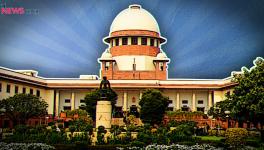Eviction Drive on Hold: Haldwani Residents Celebrate SC Order with Hugs, Tears of Joy, and Sweets

Residents celebrate the Supreme Court's order on Haldwani eviction case, in Haldwani, Thursday, Jan. 5, 2023. The apex court in its order stayed the directions of Uttarakhand High Court on the removal of encroachments from 29 acres of railway land in Banbhoolpura in Haldwani. Image Courtesy: PTI
Haldwani (Uttarakhand)/New Delhi: After weeks of anxiety and fear of losing the roof over their heads, the residents of Banbhoolpura in Haldwani celebrated January 5 even more than a festival. The Supreme Court stayed the Uttarakhand High Court’s directions for the removal of 4,365 houses from land claimed by the Indian Railways.
As the top court pronounced the order to put the eviction drive on hold, the dwellers of the locality broke into tears of joy, hugged each other, distributed sweets, and flashed victory signs.
After the Uttarakhand High Court allegedly “denied” them a fair hearing, they said that they had pinned all hope on the “apex temple” of justice — which “reconfirmed” their faith in the judiciary.
Siraj had fixed her daughter’s marriage for January 8. Worried about losing his house in lane number 16 at Banbhoolpura to the planned demolition, he had not so far concentrated on the arrangements. The SC verdict came as a mega relief for him.
“The date of marriage was finalised much before the high court order, which came as a shocker for us. We were so anxious that we had even forgotten about the marriage ceremony. It was not just about losing homes; we were facing a looming existential crisis. It does not take more than a few hours to turn a house into rubble, but an ordinary citizen earns it once in his/her lifetime,” he told NewsClick, thanking the apex court for the “humane” decision.
A resident of lane number 18 in the same locality, Nazreen, was equally worried. Her son is scheduled to get married on February 12.
“Had we been evicted, where would have we brought the bride? We don’t have words to thank the court for listening to us and passing such a favourable order,” she said.
The Supreme Court called it a “human issue” and said 50,000 people cannot be uprooted overnight. A division bench of Justices S K Kaul and A S Oka observed that some workable solution needed to be found. It also asked the state government and the railways to consider rehabilitation of the affected people as they have been living there for decades.
The matter has been listed for February 7.
The High Court on December 20 last year had ordered the removal of “encroachments” from 29 acres of railway land. But the railways had given notice to the people living on 78 acres to vacate their houses by January 7, failing which they would be evicted by force.
Shadab Alam, who resides in lane no. 16, said the decision really means ‘Satyamev Jayate’ (truth alone triumphs).
“Everyone here was fearing the imminent loss of roofs over their heads, but the Supreme Court came as a saviour,” he said, adding that he would resume going to work — which he had discontinued because of the constant mental unrest.
He claimed Banbhoolpura witnessed a hike in heart attack cases in the past 10 days and suspected the deaths might have been caused by the stress following the High Court’s order.
Faizan Ali, a resident of Indira Nagar in Banbhoolpura, said the top court saved more than 50,000 people from coming onto the roads.
“Following the shocking High Court order, women and children hit the streets and organised prayer sessions every day. And perhaps, God responded to their prayers,” he said, adding that the court’s decision is a slap on the face of those who had accused the troubled residents of waging “land jihad” and compared the women’s protests with the Shaheen Bagh sit-in against the Citizenship (Amendment) Act.
Calling the Supreme Court’s interim order based on the principle of natural justice, Advocate Yusuf, who is representing many petitioners in the district court or before the estate officer, said he expected that the apex court will continue to give the aggrieved petitioners a patient hearing and give them its protection.
Mohammad Javed, a resident of Nai Basti, talking to NewsClick about his experience said that the previous night felt like a doomsday night. “We were anxious and uncertain about our future. Taking a humane approach while dealing with the petition, the Supreme Court paid heed to our worries and passed such a wonderful order. We had faith that the highest court would come to a conclusion keeping both the facts and humanity in view. And that’s what happened. We are extremely happy,” he said.
Meanwhile, announcements were being made from mosques, cautioning people that it is not a final decision and therefore people should focus on their papers.
“The stay order has no doubt come as a relief, but it’s not a final decision. We have to produce all the documents in the Supreme Court that we could not present in the High Court. Therefore, we should work on the papers. A team of lawyers will soon be constituted to ensure better representation in the top court,” said the public message.
However, children were seen holding placards, thanking the Supreme Court for its order. With the fear of demolition not looming over their head all the time, they would now go to schools.
“I am very happy and thank the judges for the order. I hope future orders in the case will also be in our favour,” school-going Sadaf said, appealing to the government to let them live permanently in the area.
A 21-year-old undergraduate, Saba Fathima Khan, who also teaches in a local school, alleged that the planned demolition was a “targeted” attack by the Bharatiya Janata Party (BJP), which is ruling the state, on the Muslim-concentrated Banbhulpura.
“We have been living here since even before 1947. My father, who is now 50 years old, has stayed here all his life,” she said and added, “Be it CAA, NRC, NPR or the allegation of encroachment, the target is: make Muslims illegitimate citizens or declare them outsiders with no claim on the land in the country.”
Gulab Chand Sahu, who sounded very tense a couple of days back when this correspondent met him in his mohalla, Indira Nagar, Banbhoolpura, said he was now feeling “relieved” after the Supreme Court order. He told NewsClick that his father Nokhlelal Sahu had come here from Allahabad (now Prayagraj) in 1970. He was working with the Food Corporation of India, and his service record has the same address where his family lives today.
Laxmi Devi, 55, said if the railways acquire the land with a concrete compensation and rehabilitation plan, there will be no opposition.
“The Supreme Court rightly said that every occupant who has or does not have right over the land in his/her possession should be compensated. It is the bare minimum,” she added.
Advocate Salman Khurshid, who is representing one of the petitioners, Sumit Hridayesh, a Congress MLA from Haldwani, expects the decision to have a “far-reaching effect”.
“Though it is not the final verdict, the decision would provide a framework for the final judgment,” he opined.
When asked about the legal grounds cited by them in support of their claims, Mohammad Sulaiman Khan, one of the advocates, representing the petitioners, said, “In 1907, Nazul Rules were notified in Haldwani Khas. The lands were subsequently registered in the revenue records. In 1939, the Uttar Pradesh Tenancy Act came into force. And the area started to be governed by legislation as Uttarakhand was part of the erstwhile Uttar Pradesh. After independence, the state government auctioned the lands. People who bought it became auction purchasers. They got sale deeds and also the mutation done. Therefore, the petitioners have a very strong claim over the land in their possession.”
He further said the railways in 1994 said in an affidavit in one of the proceedings before the district judge that it had 45 feet of land along the eastern 70 feet along the western side of the railway crossing near the Haldwani Railway Station.
Legal experts had questioned the Uttarakhand High Court’s order to demolish over 4,000 houses and described it as “arbitrary”.
Advocate Rashmi Singh, whose office drafted the petition on behalf of the residents, said the High Court contradicted the Public Premises (Eviction of Unauthorised Occupants) Act, 1971 by not mentioning a provision for the rehabilitation of the displaced.
“More than 1,000 appeals pending before the district judge were rendered infructuous by passing the eviction order. The High Court short-circuited the entire mechanism of remedies available to people and curtailed their rights provided to them under a proper statute,” she said.
She said the court added to the injustice being perpetrated against the aggrieved people instead of protecting them and preserving their fundamental right to shelter guaranteed by Article 21 of the Indian constitution.
Get the latest reports & analysis with people's perspective on Protests, movements & deep analytical videos, discussions of the current affairs in your Telegram app. Subscribe to NewsClick's Telegram channel & get Real-Time updates on stories, as they get published on our website.
























